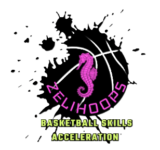When it comes to shooting a basketball, one fundamental aspect that often sparks debate is how the ball should sit in your hand. Some players shoot with a gap between their palm and the ball, while others allow the ball to rest flat on their palm. Each technique has its pros and cons, and understanding the differences can help you determine which method works best for you.
The Palm Gap Method
With this technique, the ball rests mainly on the fingers and fingertips, creating a small gap between the palm and the ball. This method is widely taught as the preferred way to shoot, as it provides better control and a softer touch.
Arguments For:
- Better Spin and Arc: Shooting with a gap allows for more backspin on the ball, which can create a softer bounce off the rim.
- Increased Control: Holding the ball primarily with the fingers provides better control, leading to more consistent shooting mechanics.
- Improved Release: A finger-controlled shot promotes a cleaner release, reducing the likelihood of the ball slipping or being pushed inaccurately.
Arguments Against:
- Requires More Strength: Some younger or less experienced players may struggle to generate enough power with just their fingers.
- More Difficult to Master: This technique takes practice to develop proper hand positioning and consistency.
NBA Example:
- Stephen Curry is a prime example of a shooter who utilizes the palm gap method. His high level of accuracy and soft shooting touch are a testament to the effectiveness of this technique.
The Flat Palm Method
With this technique, the ball rests completely on the palm, with little to no gap between the hand and the ball. Some players naturally adopt this method, as it may feel more stable and secure.
Arguments For:
- Easier for Generating Power: A flat palm allows players to use their entire hand to push the ball, making it easier to shoot from deep without relying as much on finger strength.
- Can Feel More Natural: Some players feel more comfortable with their whole hand making contact with the ball.
- Good for Larger Hands: Players with bigger hands may find this method more effective as they can still control the ball while utilizing their palm.
Arguments Against:
- Less Control: A flat palm can limit wrist flexibility, making it harder to generate spin and a smooth follow-through.
- Increased Risk of a Flat Shot: Without enough backspin, shots tend to be flatter, making them less forgiving on bounces.
NBA Example:
- Kawhi Leonard is known for using more of his palm due to his exceptionally large hands. His shooting success shows that this method can work, particularly for players with natural advantages.
Finding What Works for You
To determine which method suits you best, follow these steps:
- Experiment with Both Methods: Spend time shooting with a palm gap and a flat palm. Pay attention to comfort, accuracy, and consistency.
- Check Your Arc and Spin: Observe how the ball reacts when it hits the rim. If your shots are flat or lack backspin, a palm gap might help.
- Analyze Comfort and Power: If you struggle with power, a flatter grip might work better until you develop more finger strength.
- Watch Film of Your Shot: Recording yourself can help you identify which technique produces the best results.
Conclusion
Both shooting methods have been successfully used by NBA players and can work depending on the player’s natural feel and physical attributes. The key is to practice both, track your shooting performance, and choose the method that helps you shoot more consistently. Whether you prefer a finger-controlled shot like Stephen Curry or a palm-supported shot like Kawhi Leonard, the most important thing is finding a technique that maximizes your accuracy and confidence on the court.
